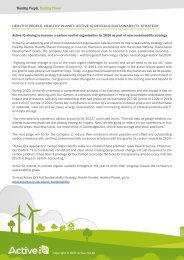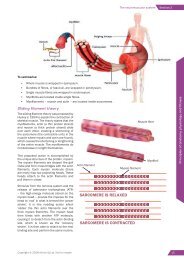Active IQ Level 3 Certificate in Pool Plant Operations (sample manual)
For more information, please visit http://www.activeiq.co.uk/qualifications/level-3/active-iq-level-3-certificate-in-pool-plant-operations
For more information, please visit http://www.activeiq.co.uk/qualifications/level-3/active-iq-level-3-certificate-in-pool-plant-operations
You also want an ePaper? Increase the reach of your titles
YUMPU automatically turns print PDFs into web optimized ePapers that Google loves.
Manual<br />
<strong>Level</strong> 3 <strong>Certificate</strong> <strong>in</strong><br />
<strong>Pool</strong> <strong>Plant</strong> <strong>Operations</strong><br />
Version A<strong>IQ</strong>004240
Section 1: The responsibilities of pool operators to provide a safe pool environment<br />
Section 1: The responsibilities of<br />
pool operators to provide a safe pool<br />
environment<br />
<strong>Pool</strong> operators, and all other <strong>in</strong>dividuals who are responsible for the management and<br />
operation of pools, have a legal responsibility to provide a safe pool environment for<br />
bathers, staff, spectators and visitors.<br />
<strong>Pool</strong> water should be clean and free from any contam<strong>in</strong>ants that may harm bathers or<br />
make them ill. Many th<strong>in</strong>gs can contam<strong>in</strong>ate a pool; these <strong>in</strong>clude physical pollutants<br />
from the human body, biological pollutants (such as bacteria or <strong>in</strong>fections), and chemical<br />
pollutants from bathers, <strong>in</strong>com<strong>in</strong>g water supplies or added by pool operators.<br />
As with any other <strong>in</strong>dustry <strong>in</strong> the UK, the Health and Safety at Work Act 1974 (HASAW)<br />
places a legal duty on pool operators to ensure a safe work<strong>in</strong>g environment and safe<br />
work<strong>in</strong>g practices. This is referred to as a ‘duty of care’.<br />
The HASAW 1974 is re<strong>in</strong>forced by the European Management of Health and Safety at<br />
Work Regulations 1999 which require managers and pool operators to carry out risk<br />
assessments and produce documents which underp<strong>in</strong> safe work<strong>in</strong>g practices. These<br />
documents are referred to as ‘Normal Operat<strong>in</strong>g Procedures’ (NOPs) and ‘Emergency<br />
Action Plans’ (EAPs).<br />
Normal Operat<strong>in</strong>g Procedures apply to the work<strong>in</strong>g environment most of the time, when<br />
everyth<strong>in</strong>g is runn<strong>in</strong>g normally. Emergency Action Plans come <strong>in</strong>to play when th<strong>in</strong>gs go<br />
wrong.<br />
Should anyone be hurt or <strong>in</strong>jured as a result of non-compliance with the law, there<br />
may be an <strong>in</strong>vestigation lead<strong>in</strong>g to the prosecution of <strong>in</strong>dividuals and organisations.<br />
Bus<strong>in</strong>esses may also become vulnerable to claims for compensation by the damaged<br />
party.<br />
There are a number of publications which provide guidance on the operation of pools, <strong>in</strong>clud<strong>in</strong>g:<br />
• Manag<strong>in</strong>g Health and Safety <strong>in</strong> Swimm<strong>in</strong>g <strong>Pool</strong>s (HSG179, 2003, third edition, published by the HSE).<br />
• Swimm<strong>in</strong>g <strong>Pool</strong> Water: treatment and quality standards for pools and spas (<strong>Pool</strong> Water Treatment Advisory Group<br />
(PWTAG), 2009).<br />
• Code of Practice: The management and treatment of swimm<strong>in</strong>g pool water (PWTAG).<br />
• Guidel<strong>in</strong>es for safe recreational water environments: volume 2, swimm<strong>in</strong>g pools and similar environments (World<br />
Health Organisation, 2006).<br />
• BS EN 13451-1:2001. Swimm<strong>in</strong>g pool equipment. Part 1. General safety requirements and test methods.<br />
• BS EN 15288-2:2008. Swimm<strong>in</strong>g pools. Safety requirements for operation.<br />
• BS EN 15288-1:2008. Swimm<strong>in</strong>g pools. Safety requirements for design.<br />
Although there are a number of guidance documents, the <strong>in</strong>dustry has adopted ‘Manag<strong>in</strong>g Health and Safety <strong>in</strong> Swimm<strong>in</strong>g<br />
<strong>Pool</strong>s (HSG179)’ and the <strong>Pool</strong> Water Treatment Advisory Group publication ‘Swimm<strong>in</strong>g <strong>Pool</strong> Water: treatment and<br />
quality standards for pools and spas’ as the key authoritative texts. Most Normal Operat<strong>in</strong>g Procedures and Emergency<br />
Action Plans for swimm<strong>in</strong>g pools are based on these two documents.<br />
These texts will be referred to throughout this <strong>manual</strong> as HSG179 (‘Manag<strong>in</strong>g Health and Safety <strong>in</strong> Swimm<strong>in</strong>g <strong>Pool</strong>s’<br />
document) and SPW (PWTAG publication ‘Swimm<strong>in</strong>g <strong>Pool</strong> Water: treatment and quality standards <strong>in</strong> pools and spas’).<br />
4 | Copyright © 2016 <strong>Active</strong> <strong>IQ</strong> Ltd. Not for resale
Section 4: The importance of good hygiene prior to pool use<br />
Po<strong>in</strong>t 1: Chang<strong>in</strong>g room floors must be kept clean<br />
by regular scrubb<strong>in</strong>g and mopp<strong>in</strong>g.<br />
Po<strong>in</strong>t 2: Bathers should be encouraged to use the<br />
toilets prior to swimm<strong>in</strong>g.<br />
Po<strong>in</strong>t 3: All bathers must be encouraged to shower<br />
prior to swimm<strong>in</strong>g <strong>in</strong> order to remove bacteria, sweat,<br />
cosmetics, etc.<br />
Po<strong>in</strong>t 4: Avoid poolside contam<strong>in</strong>ation by<br />
encourag<strong>in</strong>g the use of over-shoes. <strong>Pool</strong> surrounds to<br />
be thoroughly scrubbed.<br />
Figure 4.1 The four-po<strong>in</strong>t plan for good pool hygiene<br />
End of section: Learn<strong>in</strong>g check<br />
Answer the follow<strong>in</strong>g questions and make notes to revise this section.<br />
• What methods are adopted at your pool <strong>in</strong> order to encourage bathers to engage <strong>in</strong> pre-swim hygiene?<br />
• List three benefits for the pool operator of hav<strong>in</strong>g an effective pre-swim hygiene regime.<br />
• List three benefits for the bather of hav<strong>in</strong>g an effective pre-swim hygiene regime.<br />
Copyright © 2016 <strong>Active</strong> <strong>IQ</strong> Ltd. Not for resale | 13
Section 6: The pool water circulation system<br />
Section 6: The pool water circulation<br />
system<br />
In order for swimm<strong>in</strong>g pool water to stay safe and clear, it needs to flow through a series of processes (see figure 6.1).<br />
Swimm<strong>in</strong>g pool<br />
Heat<br />
Exchanger<br />
pH correction<br />
<strong>in</strong>jection po<strong>in</strong>t<br />
Balance<br />
Tank<br />
Note: not all pools<br />
have a balance tank<br />
A surface draw-off system removes the<br />
surface water, and water leaves the bottom of<br />
the pool through sump outlets. In deck level<br />
pools, the water is then fed <strong>in</strong>to a balance<br />
tank.<br />
Stra<strong>in</strong>er<br />
Circulat<strong>in</strong>g Pump<br />
Filter(s)<br />
Figure 6.1 <strong>Pool</strong> water circulation system<br />
Coagulant/<br />
flocculant<br />
<strong>in</strong>jection<br />
Dis<strong>in</strong>fectant<br />
Injection<br />
Po<strong>in</strong>t<br />
Sample po<strong>in</strong>t<br />
to automatic<br />
dos<strong>in</strong>g unit<br />
BALANCE TANK<br />
The balance tank (figure 6.2) accommodates<br />
the water displaced by bathers. The balance<br />
tank also provides a means of <strong>in</strong>troduc<strong>in</strong>g<br />
water <strong>in</strong>to the system to replace water used<br />
to wash the filters.<br />
Figure 6.2 A balance tank<br />
Copyright © 2016 <strong>Active</strong> <strong>IQ</strong> Ltd. Not for resale | 15
Section 6: The pool water circulation system<br />
From the balance tank, the water then passes through a stra<strong>in</strong>er (figure 6.3).<br />
The stra<strong>in</strong>er removes large particles of debris <strong>in</strong> order to protect the pump. The<br />
stra<strong>in</strong>er will remove physical debris such as plasters, hair, hair grips and bits<br />
of polystyrene. The water is then drawn by suction <strong>in</strong>to the circulat<strong>in</strong>g pump.<br />
In some smaller pools where the surface draw-off system <strong>in</strong>corporates skimmers,<br />
the skimmers themselves will also <strong>in</strong>clude a small stra<strong>in</strong>er.<br />
Figure 6.3 A typical stra<strong>in</strong>er<br />
The circulat<strong>in</strong>g pump (figure 6.4) circulates the water around the system <strong>in</strong> a<br />
similar way to how the heart pumps blood around the body. The pump has to be<br />
adequately sized <strong>in</strong> order to provide the design turnover for the pool (see unit 3).<br />
Figure 6.4 A circulation pump<br />
<strong>Pool</strong> water then passes through the filter (figure 6.5), which is responsible<br />
for remov<strong>in</strong>g f<strong>in</strong>e particles and for produc<strong>in</strong>g clear, good quality water. There<br />
are different types of filters used with<strong>in</strong> swimm<strong>in</strong>g pools, and these will be<br />
discussed <strong>in</strong> detail <strong>in</strong> unit 3.<br />
Figure 6.5 <strong>Pool</strong> water filter<br />
The water then passes through a heat exchanger (figure 6.6), which heats the<br />
water to the temperature appropriate for the type of pool. The heat exchanger<br />
(or calorifier) works on an <strong>in</strong>direct heat<strong>in</strong>g pr<strong>in</strong>ciple and heats the pool water by<br />
around 0.5°C.<br />
Figure 6.6 <strong>Pool</strong> water plate heat exchanger<br />
16 | Copyright © 2016 <strong>Active</strong> <strong>IQ</strong> Ltd. Not for resale
Section 3: Backwash<strong>in</strong>g filtration systems<br />
Although the filters should be backwashed when the pressure gauge differential reaches the level specified by the filter<br />
manufacturer, it is useful to set aside a specific time when backwash<strong>in</strong>g can be carried out, e.g. when the pool is not<br />
<strong>in</strong> use or at the end of the day.<br />
Backwash<strong>in</strong>g is typically carried out once per week on swimm<strong>in</strong>g pools, but it may be required more frequently<br />
depend<strong>in</strong>g on the bath<strong>in</strong>g load and the consequential difference <strong>in</strong> pressure between the <strong>in</strong>let and outlet pressure<br />
gauges.<br />
As part of the backwash<strong>in</strong>g process, it is possible that the level of water <strong>in</strong> the pool will be significantly lowered, so it<br />
is always safer if the backwash<strong>in</strong>g is done at a time when the pool is not <strong>in</strong> use. The best time is at the end of the day;<br />
this means that the filter sand can settle down, the plant can raise the water temperature and time is available to restore<br />
the chemical parameters ready for the follow<strong>in</strong>g day.<br />
R<strong>in</strong>s<strong>in</strong>g<br />
After backwash<strong>in</strong>g, the filter should then be r<strong>in</strong>sed to enable the sand to settle down and to flush through any dirty water<br />
which may have been lodged <strong>in</strong> the pipework.<br />
Figure 3.2 illustrates the filter<strong>in</strong>g, backwash<strong>in</strong>g and r<strong>in</strong>s<strong>in</strong>g process.<br />
Figure 3.2 The backwash<strong>in</strong>g procedure<br />
In the filtration system illustrated <strong>in</strong> figure 3.2, the valves are numbered from 1-6. <strong>Pool</strong> water enters from the left and<br />
returns to the pool via valve 4 on the bottom left. With the exception of valve 6, which is merely an air release valve and<br />
is only open for a few seconds to vent the filter after a backwash, there will only be two valves open at any one time.<br />
The valve positions for normal filtration <strong>in</strong> this example are given <strong>in</strong> table 3.1.<br />
48 | Copyright © 2016 <strong>Active</strong> <strong>IQ</strong> Ltd. Not for resale
Section 4: Valves commonly used <strong>in</strong> the swimm<strong>in</strong>g pool plant<br />
A check valve is also <strong>in</strong>corporated <strong>in</strong>to <strong>in</strong>jection po<strong>in</strong>ts and <strong>in</strong> the suction po<strong>in</strong>ts from chemical dos<strong>in</strong>g systems.<br />
Multiple-port valves<br />
Figure 4.5 Multiple-port valve<br />
This type of valve is usually restricted to smaller <strong>in</strong>stallations with plastic pipework; because of its construction, this<br />
valve is able to change several port positions by simply mov<strong>in</strong>g the handle/lever on the valve.<br />
Depend<strong>in</strong>g on the lever position, the valve can be set to filtration, backwash<strong>in</strong>g, r<strong>in</strong>s<strong>in</strong>g, bypass or dra<strong>in</strong>.<br />
This type of valve is often used <strong>in</strong> conjunction with high-rate sand filters found on small pools, spa pools and hydrotherapy<br />
pools.<br />
Advantages and disadvantages of valve types<br />
Table 4.1 addresses the advantages and disadvantages of the various valves used <strong>in</strong> swimm<strong>in</strong>g pools.<br />
TYPE OF VALVE ADVANTAGES DISADVANTAGES<br />
Gate valve Opens and closes the valve slowly. Can be over-tightened and can get<br />
jammed <strong>in</strong> the closed position.<br />
Ball valve<br />
You can see if the valve is open or<br />
closed by the position of the valve<br />
handle.<br />
None, but usually only used on<br />
plastic pipework.<br />
Copyright © 2016 <strong>Active</strong> <strong>IQ</strong> Ltd. Not for resale | 51
Section 6: Hydraulic flow of swimm<strong>in</strong>g pool water<br />
basket and empty debris that has been skimmed from the swimm<strong>in</strong>g pool. Skimmer systems remove surface water by<br />
draw<strong>in</strong>g the water to the skimmer outlets.<br />
Skimmers are often <strong>in</strong>stalled <strong>in</strong> hotel pools and smaller school pools, and they are very popular <strong>in</strong> outdoor swimm<strong>in</strong>g<br />
pools. In some cases, the skimmer basket is used as a receptacle for chemicals (such as slow<strong>in</strong>g dissolv<strong>in</strong>g chlor<strong>in</strong>e<br />
tablets). Extreme caution must be exercised when add<strong>in</strong>g any chemical <strong>in</strong> this way, as it is easy for chemicals to be<br />
accidentally mixed, which could result <strong>in</strong> the production of chlor<strong>in</strong>e gas or an explosion.<br />
Figure 6.4 Skimmers<br />
<strong>Pool</strong> outlets<br />
There are British Standards which relate to the size of apertures <strong>in</strong> grille open<strong>in</strong>gs, whether they are <strong>in</strong>let or outlet grilles.<br />
The size of the aperture should not exceed 8mm (BS EN 13451).<br />
It is also recognised that excessive suction at the outlet may cause entrapment, <strong>in</strong>jury and drown<strong>in</strong>g, so there should<br />
be a m<strong>in</strong>imum of two outlets from the pool and they need to be spaced sufficiently apart to prevent a body be<strong>in</strong>g drawn<br />
<strong>in</strong> or trapped.<br />
Where a s<strong>in</strong>gle outlet is <strong>in</strong>stalled <strong>in</strong> a pool, it is necessary to mount a protective grid cover which <strong>in</strong>creases the surface<br />
area of the grille but at the same time stops the possibility of a bather be<strong>in</strong>g sucked onto the outlet. These devices are<br />
referred to as ‘anti-vortex covers’.<br />
ACTIVITY<br />
Draw a sketch of your own pool <strong>in</strong>dicat<strong>in</strong>g where the water enters<br />
and leaves the pool and the place where <strong>sample</strong> water is taken for<br />
test<strong>in</strong>g.<br />
Figure 6.5 Anti-vortex cover<br />
End of section: Learn<strong>in</strong>g check<br />
Answer the follow<strong>in</strong>g questions and make notes to revise this section.<br />
• What sort of surface water removal system is employed at your pool?<br />
• Which of the three methods of surface water removal is considered to be the best?<br />
• How does the swimm<strong>in</strong>g pool water circulate from the <strong>in</strong>lets to the outlets <strong>in</strong> your own pool?<br />
• How many <strong>in</strong>lets are there at your pool? Where are they?<br />
• How many outlets are there at your pool?<br />
• Why are s<strong>in</strong>gle outlets a problem? How is this problem addressed <strong>in</strong> practice?<br />
Copyright © 2016 <strong>Active</strong> <strong>IQ</strong> Ltd. Not for resale | 95

















